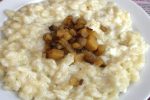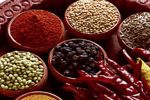West African Food Facts

A truly populous region, with numerous languages and cultures. As vast as the cooking styles are it is true to say that a typical West African meal is heavy with starchy items, meat, spices and flavors. A wide array of staples are eaten across the region including those of; Fufu, Banku and Kenkey (originating from Ghana), Foutou, Couscous, and Garri which are served alongside soups and stews.
The main starch based food eaten in many areas is Fufu which is often made from starchy root vegetables such as yams, cocoyams, or cassava, but also from cereal grains like millet, sorghum or plantains. The versatility of the grain utilized depends on the region and ethnic group to ethnic group, although corn has gained significant ground as it is cheap, swells to greater volumes and creates a beautiful white final product that is greatly desired. Rice-dishes are also widely eaten in the region, especially in the dry Sahel belt inland.
The colonial era brought forth both chilies and tomatoes which have become ubiquitous components of West African cuisines. Hence the latter are used heavily within rice dishes and stews such as Jollof rice.
In the whole the local cuisine and recipes of West Africa continue to remain deeply entrenched in the local customs and traditions, with ingredients like native rice (oryza glaberrima), millet, sorghum, Bambara and Hausa groundnuts, black-eyed beans, brown beans, and root vegetables such as yams, cocoyams, and cassava.
With regard to beverages, water has a very strong ritual significance in many West African nations (particularly in dry areas). Traditional root drinks such as Palm wine are also a common beverage made from the fermented sap of various types of palm trees and is usually sold in sweet (less-fermented, retaining more of the sap’s sugar). Millet beer is another common beverage all of which are highly sought after by Immigrant West African populations right across the world




